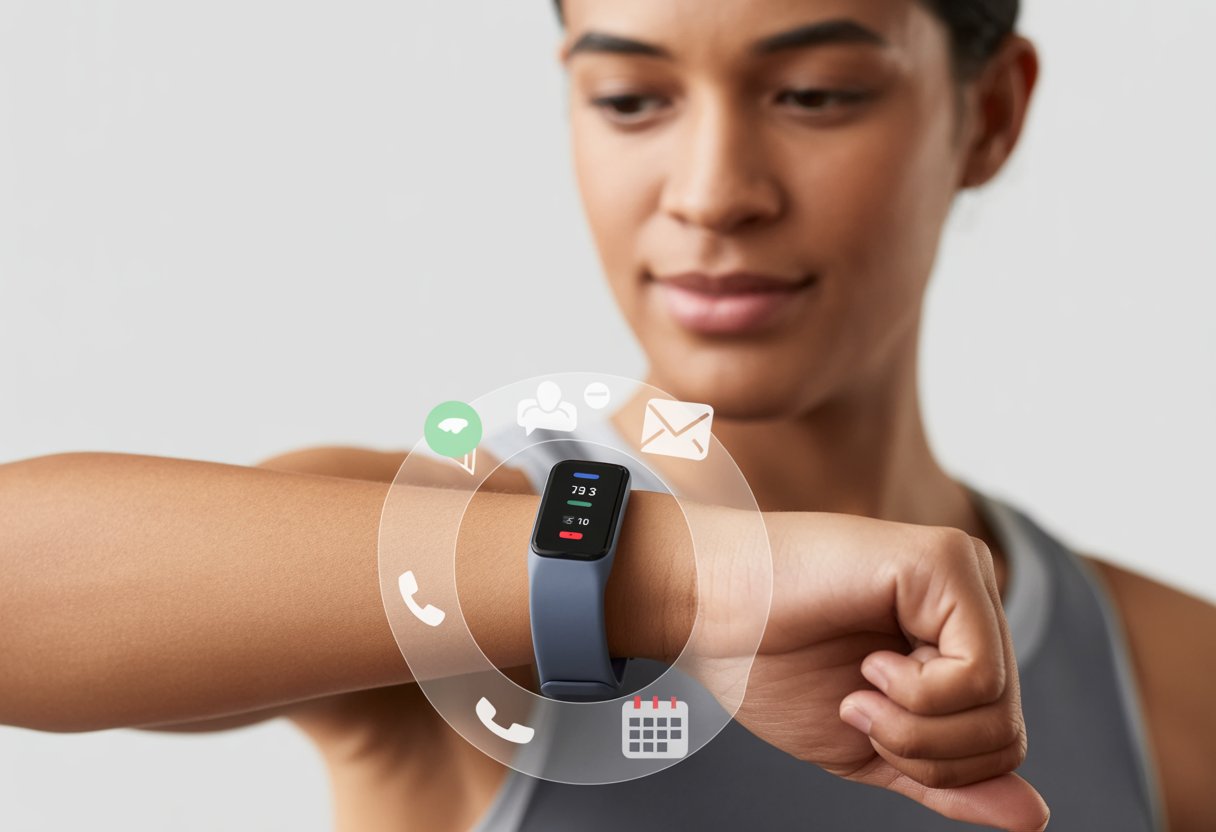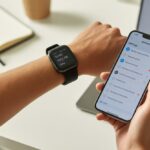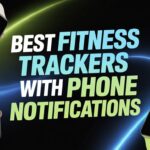Let’s be honest—our phones constantly fight for our attention. Wouldn’t it be easier to get the notifications we care about—like texts or reminders—on our wrists instead of fishing out our phones every five minutes?
Using a fitness tracker for notifications helps us stay in the loop while we’re moving, working out, or, let’s be real, just pretending to exercise. Now, we don’t have to lose focus or stop mid-stride just to check if that buzz is urgent or just another group chat.

Setting up a fitness tracker for alerts? It’s honestly not rocket science. We get to pick and choose what pops up, so we’re not bombarded by every single app—unless we really want to know about every new meme.
For example, Fitbit lets us personalize notifications right from its app. This saves us from endless pings and that dreaded notification overload. The Fitbit help center has a handy guide here.
With just a bit of setup, our fitness tracker does more than count steps or silently judge us for skipping leg day. It works as our own mini assistant, delivering only the alerts we care about, right when we need them.
Understanding Notifications On Fitness Trackers
Fitness trackers have moved way past just counting steps. Now, we can turn our wrists into little command centers and never miss a call, message, or reminder—even if our phone is buried on the other side of the room.
What Are Notifications?
Notifications are those quick messages or alerts that our phone or certain apps send to our fitness tracker. These little pop-ups show up on our wrist, sometimes with a buzz or a flash, trying to get our attention.
Don’t worry, our tracker won’t tattle on us for finishing an entire bag of chips (yet). Usually, these notifications show up as short bursts—like a text or a reminder.
Bluetooth keeps our tracker in sync with our phone, so we can see what’s happening without digging for our phone. We decide which notifications appear, and honestly, it’s a relief to dodge Aunt Linda’s bingo invites.
Just jump into the companion app or device settings and pick what matters.
Types of Notifications You Can Receive
Our fitness tracker can buzz us about a bunch of things. The most common notifications are:
- Text Messages: We can buzz, read, and sometimes even reply straight from our wrist. Secret agent vibes, anyone?
- Calls: See who’s calling, and sometimes answer or decline if we feel brave.
- App Alerts: Get updates from social media, news, or weather apps.
- Calendar Reminders: Never forget a meeting or that dentist appointment we keep rescheduling.
- Fitness Goals: Our tracker cheers us on or nudges us if we’ve been sitting too long.
Trackers like Fitbit and Apple Watch make it easy to adjust these settings. On Fitbit, for instance, we get to choose which calls, texts, and app updates show up, so we’re not glued to our phones. You can dive deeper into setup or check out the Fitbit notification help.
Setting Up Notification Alerts
Getting notifications on our fitness tracker feels like a neat little upgrade, but we need to set things up first. If we want our tracker to buzz for calls, texts, or app alerts, we should make sure the connection is solid and only the right apps get through.
No one wants a hundred notifications about Aunt Edna’s cats.
Connecting Your Tracker to Your Phone
First, let’s get our tracker and phone talking. We usually do this with the tracker’s companion app.
Open the app, log in, and look for “Set Up Device” or “Pair Device.” Bluetooth needs to be on—otherwise, nothing’s going to happen.
Follow the prompts until our tracker’s name shows up. Tap it, and wait for the confirmation. Sometimes, we have to enter a code (usually just four numbers, nothing wild).
Once the tracker says it’s connected, we’re good to go. Fitbit has official setup instructions if you need a walkthrough.
Configuring Which Alerts Appear
Now, it’s time to take control. In the app, find the “Notifications” section.
We’ll see options for calls, texts, calendar, and other apps. Toggle these on or off—just like flipping switches.
We don’t need every app buzzing us. Who really wants a notification for every FarmVille cow? Select only the alerts that actually matter.
If we want text previews, set “Show Previews” to Always or When Unlocked on our phone, so we’re not left guessing.
The Fitbit notification guide has more tips if we get stuck.
If we mess up, it’s easy to turn things off or on again until everything feels right. No need to call tech support.
Customizing Your Notification Preferences
Fitness trackers can do a lot more than count steps. They help us stay connected, but only if we wrangle the buzzing and beeping into something manageable.
Adjusting notification settings keeps us in control and cuts down on distractions.
Prioritizing Important Notifications
Nobody wants their wrist buzzing every time someone likes a cat meme. We need to pick notifications that actually matter.
Trackers like Fitbit, Apple Watch, and Garmin let us decide which apps can send alerts. For Fitbit, we find these controls in the app’s “Notifications” section. On Apple Watch, it’s in the “My Watch” area.
It’s usually best to focus on messages, calls, and calendar reminders. Social media likes or game updates? Not so much.
If we use a Garmin, we can fine-tune which apps can alert us in the Garmin Connect app.
Quick checklist for prioritizing:
- Pick essential apps (calls, messages)
- Turn off nonessential ones (games, social media)
- Check settings every few months to keep things tidy
Muting and Filtering Distractions
Silent mode and Do Not Disturb are lifesavers. Sometimes, we just need peace—during meetings, sleep, or movie nights.
Most fitness trackers have quick settings like “Do Not Disturb” (DND) or “Sleep Mode” that mute alerts until we’re ready.
For example, on Fitbit, we just swipe down to access quick settings and flip DND on or off. This way, we won’t jump out of our seats during a scary movie.
Some trackers let us filter which alerts get through during DND. We can keep emergency notifications active but hide everything else. Muting group chats but letting direct messages through is also possible.
If our watch still interrupts us, it’s worth checking for sneaky app settings that might override our silence. Nobody wants to miss a message from the boss but get woken up by a sale alert.
Setting Notification Schedules
We’re not glued to our wrists every minute, and our notifications shouldn’t be either. Scheduling helps.
Many fitness trackers let us set custom notification times. For example, we can keep our watches quiet at night or only get alerts during work hours.
Fitbit lets us turn Sleep Mode on automatically based on a schedule. On Apple Watch, we can bundle notifications and see them only at certain times.
Setting a schedule means fewer interruptions when we need to focus. We can let work alerts through at our desks and silence everything else during dinner.
Why schedule notifications?
- Less distraction when we need to concentrate
- Better sleep with alerts off at night
- More control over our day
Mixing schedules with muting and prioritizing means we finally get a little peace—or at least fewer surprises from our wrists.
Popular Fitness Trackers With Notification Features
Phones buzzing off the table is annoying. With fitness trackers, we can check messages, alerts, and calls without grabbing our phones every time.
Some trackers make handling notifications way easier—and less awkward during meetings.
Apple Watch Capabilities
We all know someone who’s sent a text from their wrist and felt like James Bond. The Apple Watch really takes notifications up a notch.
It pushes calls, texts, and app alerts straight from our iPhone to our wrist. The screen is bright, and the haptic feedback makes sure we feel every buzz—even in noisy places.
With Apple Watch, we can reply to messages using voice, scribbles, emojis, or canned responses. Sometimes, “LOL” is all we’ve got.
It handles calendar reminders, alarms, social media, and news updates too. If our phone is nearby, we won’t miss much.
Settings let us filter what pings our wrist, so we can keep the important stuff and hush those never-ending group chats.
Fitbit Notification Integration
Fitbit devices like the Charge and Versa series keep things simple. We get texts, calls, and calendar notifications right on our wrist—no more digging for our phones in the middle of a workout.
Most Fitbits let us customize which notifications show up, so we’re not distracted all day. Some models let us send quick replies (especially if we’re using Android—sorry, iPhone fans).
The screens are smaller than Apple Watch, but they still show who’s calling or texting. We can also get alerts from WhatsApp, Facebook, and other apps.
Fitness and notifications work together, so we don’t have to pick between getting our steps and reading memes. For more on the latest models, check out this guide to the best fitness trackers.
Managing Sleep Tracking And Nighttime Alerts
Good sleep is priceless, but nobody wants a vibrating wrist at 3 a.m. Sleep tracking helps us see how well we’re resting, but managing nighttime alerts is what keeps us from waking up annoyed.
Disabling Nighttime Disturbances
If we want to wake up refreshed, we need to mute notifications during sleep hours. Most fitness trackers let us do this with a Do Not Disturb mode or a sleep schedule.
For example, on Fitbit, we can wear the device to bed and check our sleep stats in the morning, but first, we need to switch off alerts (tracked here).
We should double-check that silent or bedtime modes match our sleep habits. These settings usually mute calls, texts, and those “you hit your step goal” celebrations.
If we set the wrong hours, we might get woken up by a buzz or miss our alarm and blame the tracker. Some trackers let us pick which notifications get through.
It’s smart to only allow essential alerts—like a “you left your oven on” reminder—while muting the rest.
Using Sleep Tracking in Harmony With Alerts
We want our fitness tracker to feel like a sleep buddy, not some nagging roommate. If we set things up right, our tracker records our sleep patterns without waking us up or buzzing at odd hours.
The trick is syncing notifications and sleep tracking just right. First, we wear the tracker snugly above the wrist bone—those sensors need a good spot to do their job (as explained here).
Then, we tweak notification settings so alerts stay quiet at night. Most tracker apps let us tie sleep schedules to notification settings, so if we tell the tracker when we plan to sleep, it keeps things silent until our alarm goes off.
It’s worth checking for special features like “Sleep Focus” mode, which automatically mutes most notifications. That way, we wake up to a neat sleep report instead of spam texts at 3 a.m.
When we use sleep tracking and notifications together, we get better rest and still catch alerts when we’re actually awake.
Troubleshooting Notification Issues
Even fitness trackers sometimes “forget” to pass along our phone notifications. Let’s see how we can get those calls, texts, and reminders working again—no detective work required.
Sometimes, all it takes is a little patience and a few quick steps.
Common Connection Problems
We’ve all had our tracker suddenly stop buzzing about texts or calls. Usually, the tracker just lost its connection to the phone, like two friends who stopped talking.
First, we check that Bluetooth is on for both devices. No Bluetooth? Nothing’s getting through. If things still act up, a quick restart for both the phone and tracker works wonders.
If notifications still aren’t coming through, we try turning notifications off in the app, syncing, then turning them back on. This “off and on again” move often does the trick, as folks mention in the Fitbit Community.
It also helps to update the app and tracker. Old software can cause all sorts of weird issues.
Solving Notification Delays
Notification delays feel like hearing yesterday’s news today. First, we check if our phone’s Do Not Disturb is on—if it is, our tracker won’t get alerts either.
Regular syncing helps keep notifications timely. Syncing the tracker with our phone (kind of like matching socks) keeps everything running smoothly.
If that fails, we can delete the tracker from the app and pair it again. It’s a fresh start, like putting shoes on the right feet for once. For more tips, check out the Fitbit app guidance.
A strong Bluetooth connection and the right app permissions matter, too. Sometimes, we just need to give our devices the privacy settings they want—turns out, our tracker likes its rules.
Maximizing Daily Productivity With Smart Alerts
With a fitness tracker on our wrist, we catch notifications faster than most people catch a cold. Smart alerts let us handle work texts and water reminders without anyone noticing.
Staying In The Loop Without Checking Your Phone
We all know the feeling—our phones buzz, and suddenly we’re lost in memes and missed deadlines. With a watch, notifications land quietly on our wrist instead.
We can see who’s calling, read a message, or check a calendar alert in a second or two. There’s no more dragging our phones out just to get sidetracked.
Smart alerts are customizable, so we get the stuff we care about and skip the rest. A quick glance keeps us in the loop for what matters.
This makes us look busy and professional, even if we’re just reading about Susan’s lunch in the group chat. For more tips on staying productive with smartwatches, check out InfoMoreSpace.
Balancing Fitness And Personal Notifications
It’s not always business. We want to hit our step goals, sure, but who wants to miss a pizza delivery alert or a message from family? Fitness trackers let us choose which notifications sneak through our workout mode.
Nobody needs a Slack ping during downward dog, so we just mute those work emails while we exercise or meditate. On the other hand, those health nudges—reminders to stand up, or a little celebration for closing a ring—actually help us stay motivated.
Honestly, when my watch gives me that little vibrating high-five, it feels like a win, even if I’m just walking to the fridge. By picking what shows up and when, we keep our heads in the game for both fitness and everything else life throws at us.
We get the alerts we care about, and a break from the noise. Want some tips for making these settings work for you? Check out Robin Waite’s post on how an Apple Watch streamlines workdays.
- Best Smartwatches for Teenagers: Because Your Wrist Deserves Better Than a Friendship Bracelet - November 9, 2025
- Why is my fitness tracker not displaying correctly in sunlight? How Your Watch Became a Vampire - November 8, 2025
- Why is my fitness tracker not showing Facebook notifications? Your Steps Count, But Your Likes Don’t - November 8, 2025






